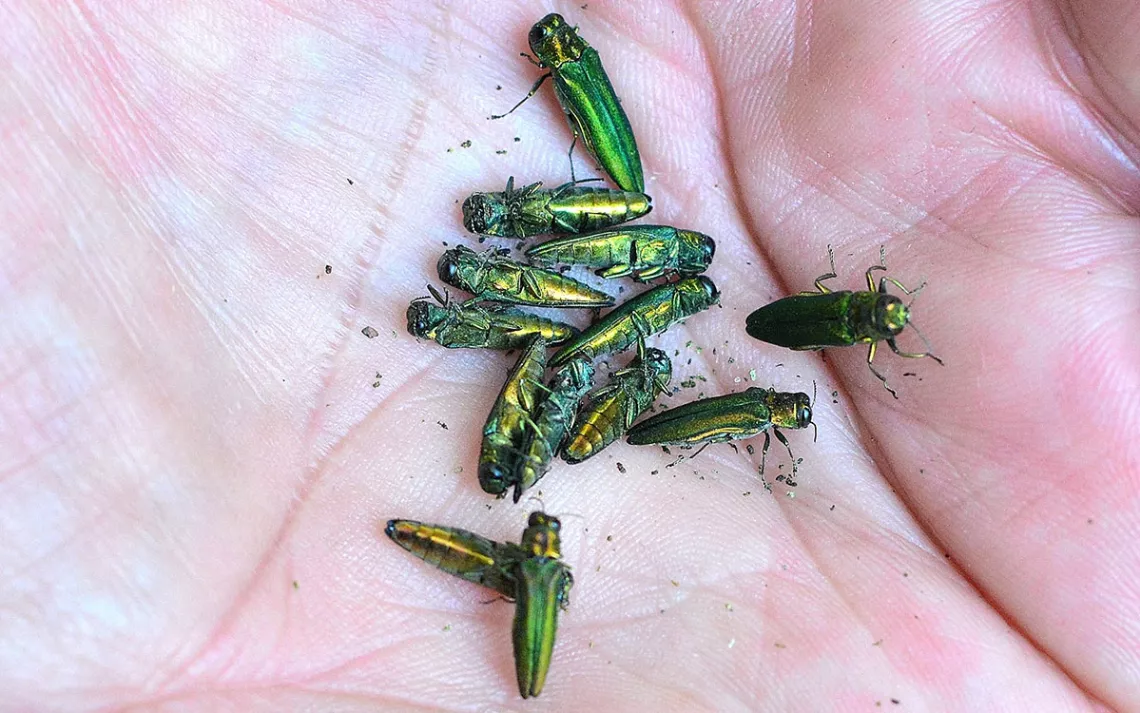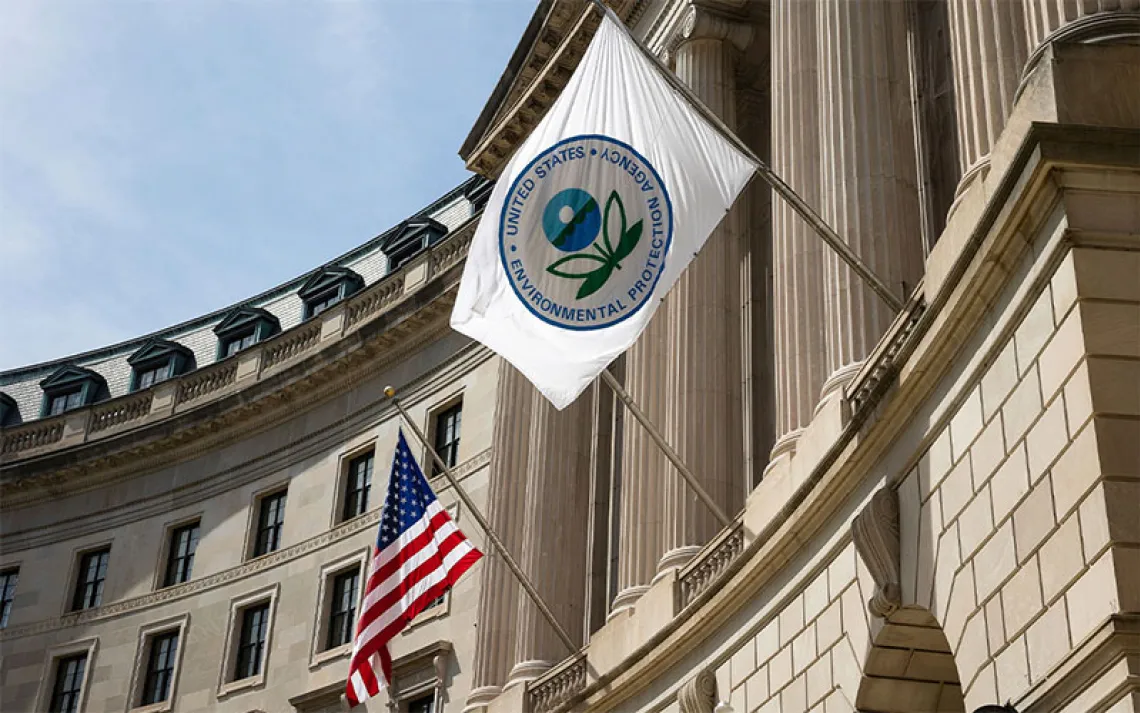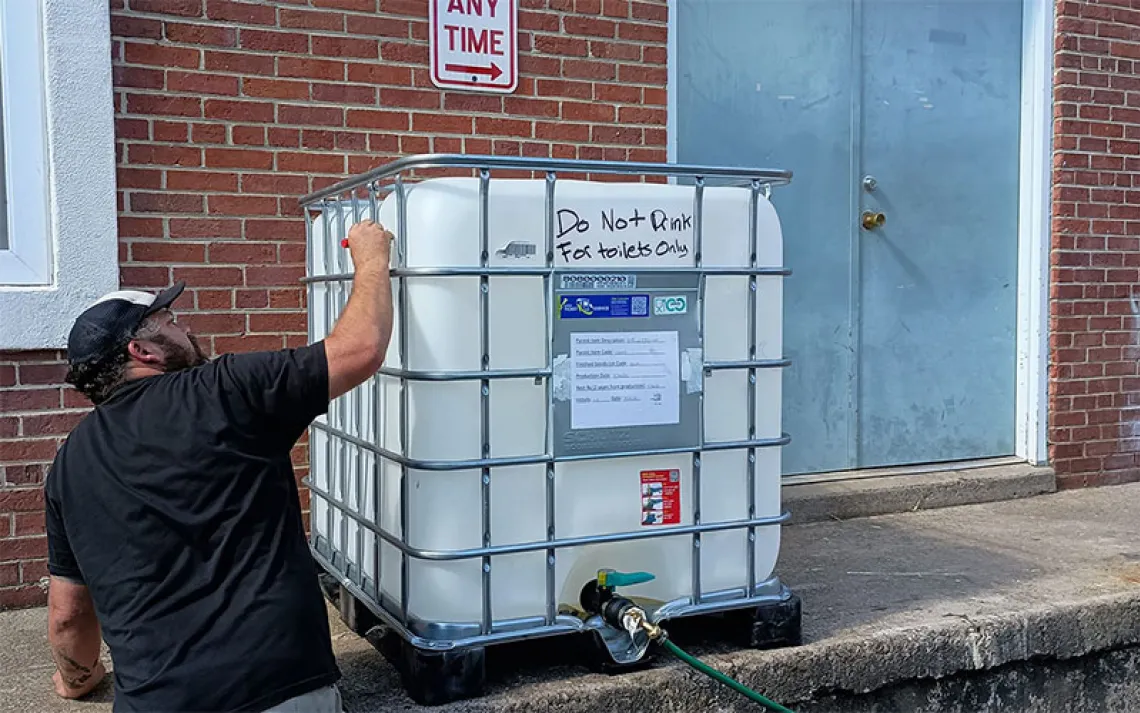Ash Trees Are Dying Everywhere. This Is Why.
A bug is going to make your summers hotter

Emerald ash borers that have fallen from an ash tree several days after it was injected with a pesticide. | Photo by ziggy1/iStock
An ash tree may not be a particularly memorable tree—not as iconic as a maple, not as majestic as an oak, not as whimsical as a ginkgo—but it is a good tree. A sturdy trunk stretches out into wide branches, where long clusters of oval-shaped leaves fill the canopy and provide a dappled, dignified shade.
Ashes have also become one of the most common trees along city streets and parks in many parts of North America—in Dallas, for example, ashes make up about 13 percent of all city trees and in Chicago, that number is about 17 percent. This expanse puts the trees’ canopies to good use. By providing shade and evaporating water through their leaves, they can cool down their surroundings—meaning the ash trees now dotting urban areas are a huge help when it comes to battling extreme heat.
But at the same time, ash trees are facing another ecological danger: the invasive emerald ash borer. This minuscule insect can kill an ash tree within just a few years after laying its eggs in the tree’s bark, and in some cities, they’ve already decimated much of the local ash population. According to the US Department of Agriculture, the bugs have spread to 36 states, DC, and five Canadian provinces, killing millions of ash trees as they expand their range. What researchers are starting to find out now is that the disappearance of these trees could exacerbate an already growing threat in cities and towns: increasing temperatures.
The emerald ash borer, native to eastern Asia, is quite striking. The insect, less than an inch long, wears a spectacular and shimmering pair of wings that catch the light and reflect an almost unnaturally bright green. Hidden beneath those wings is a just-as-astoundingly crimson abdomen—and if that weren’t charming enough, the ash borer’s face looks almost exactly like a classic science fiction alien, with big, black eyes taking over half its head.
Yet by the time you spot this masterpiece of evolution, it’s probably already too late for the ash trees, says Emma Hudgins, an ecologist at the University of Melbourne. The insects lay their eggs under the tree’s bark, where they’ll hatch about a week later. These larvae chew around underneath the bark, slowly digging curving tunnels just below the surface of the tree. Eventually, the ash borers pupate, transmogrify into their adult forms, emerge from the tree, and fly off in search of a mate so the next generation can repeat the cycle all over again.
For an ash tree, this process can be fatal. Trees transport nutrients and water through their bark, and by gouging holes through that bark, the ash borers sever the tree’s roots from its branches. “It essentially cuts off the circulation of the tree,” Hudgins says.
The ash borer was first spotted in North America in 2002. One of the first major American cities it reached was Chicago, which has now been battling the insects for nearly two decades, with devastating results. According to a report by the local Morton Arboretum, while there were about 13 million ash trees in the Chicago area in 2010, that number had dropped to under 7 million by 2020, with 4 million more trees either dying or already dead.
This kind of tree loss could spell trouble for extreme heat in an urban area. Cities are naturally hotter than rural areas, in large part because materials like concrete and asphalt in sidewalks, roads, and buildings can absorb a lot of heat from the sun. That heat then radiates back out into the cityscape—making temperatures a few degrees hotter than their surroundings.
Trees can be a city’s greatest defense against this effect. Their shade blocks the sunlight from ever reaching sidewalks, roads, and buildings, preventing them from heating up in the first place. What’s more, trees can disperse heat out of the air by pulling water up from the ground and evaporating it out through their leaves. This is why it often feels slightly cooler in city parks or under the bough of a large tree.
A few years ago, Deidre Jaeger, a post-doctoral ecologist at the University of Colorado Boulder, wanted to see what the ash borer’s spread might mean for her city’s temperatures. Ash trees make up about a quarter of Boulder’s canopy, and the collective impact of losing those trees could be significant. Deidre and her colleagues placed thermometers under two ash trees on the university’s campus, both of which were scheduled to be removed due to ash-borer infestation. They also placed another thermometer in a nearby patch of open sun and another under an infested ash tree not scheduled for removal.
In the days after the two ash trees were removed, ambient temperatures under those trees increased by a little less than one degree compared with the control temperature in the open sun. While this was a small increase, these were also just two individual trees in a leafy corner of campus, indicating that even removing a mere fraction of the canopy might lead to a detectable, localized temperature increase.

Sign up to receive Sierra News & Views
Get articles like this one sent directly to your inbox weekly.
With this action you affirm you want to receive Sierra Club communications and may vote on policy designated by the Sierra Club Board.
Jaeger notes that she wanted to study this on a larger scale but that the logistics of finding trees to study before they were removed ended up being very complicated. But it stands to reason that as the ash borers continue to decimate tree canopy in cities across North America, they could take away the heat protection those trees offered. One 2019 study found that in US counties with emerald ash borers, average monthly temperatures increased by 0.09°F, and max monthly temperatures increased by 0.28°F after the insects showed up. That same study also found that post-ash-borer invasion, counties were 2.1 percent more likely to see at least one day each month with temperatures of at least 90°F.
To reduce the potential of this warming trend, some states are trying to slow the ash borer's spread. For instance, many states have regulations on moving ash wood, which is one way the insects spread. Still, this isn’t enough to completely stop their spread. The ash borer will likely keep expanding its range, ash trees will likely keep dying, and cities will need to replace those trees with new growth.
Climatewire reports that this effort could be supported by federal funding. Urban foresters could also use new knowledge of tree ecology to create more resilient and sustainable urban forests moving forward. “What we need to be doing is not just focusing on what we've lost but what we've learned,” says Nathan Maren, a horticulturist at the Morton Arboretum in Chicago.
To start, that likely means planting a more diverse urban forest. Part of the reason why ash trees are so common in cities is because Dutch elm disease had killed off many of the elm trees living in cities, and ash trees were a cheap and prevalent replacement, Hudgins the ecologist says. If cities replanted with a wide variety of tree species instead, that could lower the risk of a single insect species decimating the canopy, Jaeger notes. Similarly, urban forests need to be taken care of to thrive, which means engaging the communities that live among these trees.
The Morton Arboretum is also researching varieties of ash trees that may be more resistant to the ash borer, though Maren says that research will likely take at least another couple of decades before it’s applicable. In the meantime, any trees planted to replace infested ashes will take a while to become large enough to provide a significant cooling effect. In other words, no matter what the solution might be, it might behoove cities to get started.
 The Magazine of The Sierra Club
The Magazine of The Sierra Club



